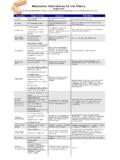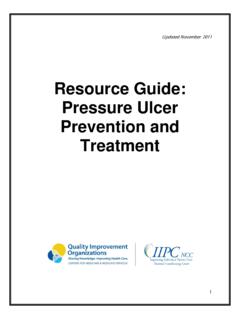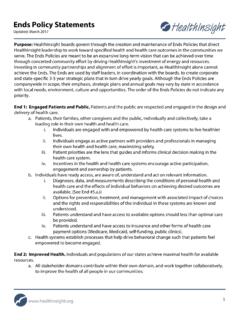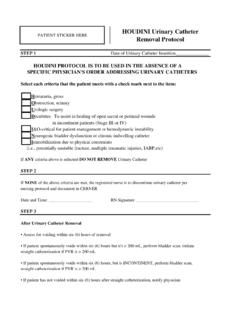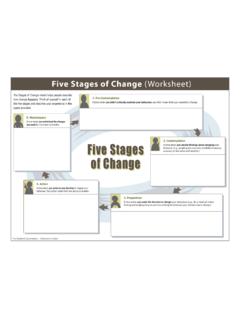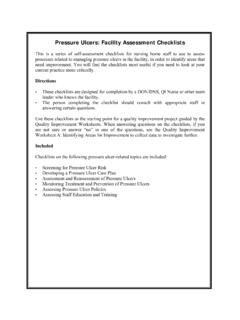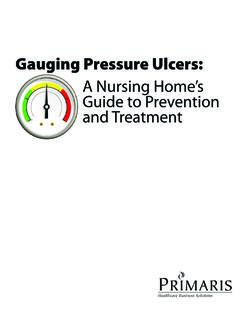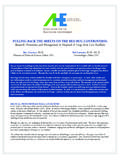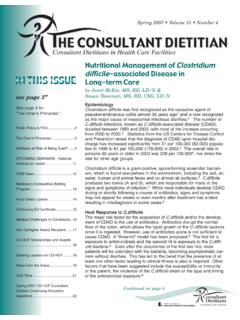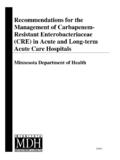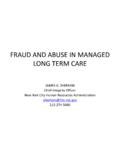Transcription of Effective Management of Urinary Incontinence in …
1 Effective Management of Urinary Incontinence in long -Term care facilities Train the Trainer ManualMarch 2000 Effective Management of Urinary Incontinence in long -Term care facilities Table of Contents Learning Licensed Licensed Assessment Medication AHCPR Voiding Post 100 Roscommon Drive Middletown, Connecticut 06457 (860) 632-2008 Qualidigm INTRODUCTION Effective Management of Urinary Incontinence in long -Term care facilities Train the Trainer Manual Urinary Incontinence remains a major health problem in long term care . The challenges to effectively manage this health problem can often appear daunting. The development of our Urinary Incontinence Project grew from our desire to improve the quality of care related to residents with Urinary Incontinence , thereby improving their quality of life.
2 Upon completion of our baseline evaluation of your facilities , it was concluded that the comprehensive assessment of Urinary Incontinence was not addressed completely. Thus, it was difficult to develop Effective Urinary Incontinence diagnoses with subsequent Effective Management strategies without the appropriate assessment. The following "Train the Trainer" manual was collectively developed based on your suggestions and recommendations to further educate your staff on Urinary Incontinence assessment and Effective Management . You will note the common theme of "assessment is key" throughout the manual, since it is the assessment that drives the plan of care . We hope, as you review and use the manual in your staff development activities related to Urinary Incontinence , that you will find it "user friendly" and an excellent resource for continuing education.
3 Since this manual is intended as an additional intervention during this continuous quality improvement project, we hope you find the tools useful in improving the awareness and knowledge required to deliver the best continence care possible. Sincerely, Courtney H. Lyder, ND, GNP Clinical Coordinator Anne Elwell, RN Project Manager Anne Spenard, RN,C, MSN Clinical Consultant LEARNING OBJECTIVES Effective Management of Urinary Incontinence in long -Term care facilities LEARNING OBJECTIVES Upon completion of this training program, licensed staff will be able to: describe common reversible causes of Urinary Incontinence differentiate between chronic types of Urinary Incontinence and describe appropriate treatment options for each diagnosis describe evaluation procedures, which are appropriate for establishing diagnosis of Urinary Incontinence in the long -term care setting describe the process for completing the Urinary Incontinence Physical Assessment and History Form describe all the components for completing the physical examination for Urinary Incontinence Qualidigm Page 2 Effective Management of Urinary Incontinence in long -Term care facilities LEARNING OBJECTIVES Upon completion of this training program, CNAs will be able to.
4 Describe common types of Urinary Incontinence describe how to complete the 3 day voiding diary describe the techniques in bladder training facilitate pelvic muscle (Kegel) exercises identify the steps to facilitating Urinary Incontinence Qualidigm Page 3 STEPS TO CONTINENCE 1. Complete Physical Assessment and History Form 2. Determine the type of Urinary Incontinence 3. Complete Algorithm PRESENTATION - Licensed Staff (for speaker s notes please refer to the ppt file) Overview of Urinary Incontinence (UI) in the long Term care FacilityEvaluation and ManagementAnn M. Spenard RN, C, MSNC ourtney Lyder ND, GNPL earning Objectives Describe common reversible causes of UI Differentiate between chronic types of UI and describe appropriate treatment options for each diagnosis Describe evaluation procedures, which are appropriate for establishing diagnosis of UI in the long -term care setting Describe the process for completing the UI Physical Assessment and History Form Describe all the components for completing the physical examination for Urinary incontinenceSteps to Physical Assessment and History the type of Urinary AlgorithmEvaluation is the Key!
5 Identification of the type of Urinary Incontinence is the key to Effective an accurate and comprehensive UI History Prevalence of Urinary Incontinence Estimated 10% to 35% of adults >50% of million nursing home residents A conservative estimated cost of $ billion per year for Urinary Incontinence in nursing homes Fant Managing Acute and Chronic Urinary Incontinence . Rockville, MD Agency for Health care Policy and Research. 1996. AHCPR Publication No. 90-06 National Center for Health Statistics. Vital Health Statistics Series. 13(No. 102). 1989e inImpact on Quality of Life Loss of self-esteem Decreased ability to maintain independent lifestyle Increased dependence on caregivers for activities of daily life Avoidance of social activity and interaction Restricted sexual activityGrimby et al.
6 Age Aging. 1993; 22 T. Aging in the Eighties: Prevalence and Impact of Urinary Problems in Individuals Age 65 and Over. Washington DC: Dept. of Health and Human Services, National Center for Health Statistics, No 121, L. Gerontologist. 1987; 27 of UI An increased propensity for falls Most hip fractures in elders can be traced to nocturia especially if combined with urgency Risk of hip fracture increases with)physical decline from reduced activity)cognitive impairments that may accompany a UTI)medications often used to treat Incontinence )loss of sleep related to nocturiaRisk Factors Aging Medication side effects High impact exercise Menopause ChildbirthFactors Contributing to Urinary Incontinence Medications)Diuretics)Antidepressants)An tihypertensives)Hypnotics)Analgesics)Nar cotics)Sedatives Diet)Caffeine)Alcohol Bowel Irregularities)Constipation)
7 Fecal ImpactionAge Related Changes in the Genitourinary Tract Majority of urine production occurs at rest Bladder capacity is diminished Quantity of residual urine is increased Bladder contractions become uninhibited (detrusor instability) Desire to void is delayedTypes of Urinary Incontinence Stress Urge Mixed Overflow TotalTypes of Urinary Incontinence Stress:Leakage of small amounts of urine as a result of increased pressure on the abdominal muscles (coughing, laughing, sneezing, lifting) Urge:Strong desire to void but the inability to wait long enough to get to a bathroomTypes of Urinary Incontinence (continued) Mixed:A combination of two types, stress and urge Overflow:Occurs when the bladder overfills and small amounts of urine spill out (bladder never empties completely, so it is constantly filling) Total:Complete loss of bladder Incontinence canbe treated even if the resident has dementia!
8 !Cause of Stress Urinary Incontinence Failure to store secondary to urethral sphincter incompetenceCauses of Urge Urinary Incontinence Failure to store, secondary to bladder dysfunction )Involuntary bladder contractions)Decreased bladder compliance)Severe bladder hypersensitivityStress Incontinence vs. Urge Incontinence : System Check ListSymptomsStressIncontinenceUrgeIncont inenceUrgency accompanies Incontinence (strong, sudden desire to void)NOYESL eaking during physical activity ( , sneezing, lifting, etc.)YESNOA bility to reach the toilet in time,following an urge to voidYESNOW aking to pass urine at nightSELDOMOFTENC auses of Mixed Urinary Incontinence Combination of bladder overactivity and stress Incontinence One type of symptom ( , urge or stress Incontinence ) often predominatesSymptoms of Overactive Bladder Urgency Frequency Nocturia, and/or urge Incontinence ANY COMBINATION -in the absence of any local pathological or metabolic disorderCauses of Overflow Urinary Incontinence Loss of urine associated with over distention of the bladder Failure to empty)Underactive bladder Vitamin B12deficiency Outlet obstruction)Enlarged Prostate)Urethral Stricture)Fecal Impaction Neurological Conditions)Diabetic Neuropathy)Low Spinal Cord Injury)
9 Radical Pelvic SurgeryNeurogenic BladderWhat is a neurogenic bladder? A medical term for overflow Incontinence , secondary to a neurologic problem However, this is NOTa type of Urinary incontinenceBasic Types and Underlying Causes of IncontinenceTypeDefinitionCausesStressLo ss of urine with increase in intra-abdominal pressure (coughing,laughing, exercise, standing, etc.)Weakness and laxity ofpelvic floor musculature,bladder outlet or urethralsphincter weaknessUrgeLeakage of urine because ofinability to delay voiding aftersensation of bladder fullness isperceivedDetrusor muscle instability,hypersensivity associatedwith local genitourinaryconditions or centralnervous system disordersOverflowLeakage of urine resulting frommechanical forces on an overdistended bladder, or from othereffects of Urinary retention onbladder and sphincter functionAnatomic obstruction byprostate, stricture,cystocele, acontractilebladder, detrusor-sphincterdyssynergyMixedUrinary leakage associated withinability to toilet because ofimpairment of cognitive and/orphysical functioning, unwillingness,or environmental barriersSevere dementia.
10 Otherconditions that causesevere immobility, andpsychological factorsReversible or Transient Conditions That May Contribute to UI D DeliriumDehydration* R Restricted mobility Retention I InfectionInflammationImpaction P PolyuriaPharmaceuticals*Dehydration Dehydration due to decreased fluid intake; increased output from diuretics, diabetes, or caffeinated beverages; or increased fluid volume due to congestive heart failure can concentrate the urine (increased specific gravity) and also lead to fecal impaction The specific gravity of the urine can be tested to determine whether or not the resident is dehydratedBasic Evaluation Physical Exam Female genitalia abnormalities)Rectocele)Urethral Prolapse)Cystocele)Atrophic VaginitisBasic Evaluation for Differential Diagnosis Patient History)Focus on medical, neurological, genitourinary)Review voiding patterns and medications)Voiding diary)Administer mental status exam, if appropriate Physical Exam)General, abdominal and rectal exam)Pelvic exam in women, genital exam in men)Observe urine loss by having patient cough vigorouslyBasic Evaluation for Differential Diagnosis (continued) Urinalysis)
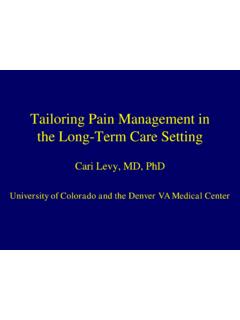
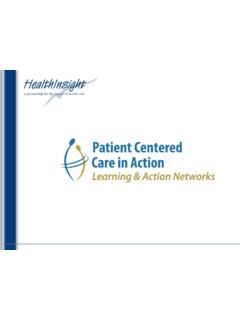
![2014 QAPI Plan for [Facility Name]](/cache/preview/6/6/9/d/c/1/a/b/thumb-669dc1ab5a6c622d3e508ca0e8604845.jpg)
